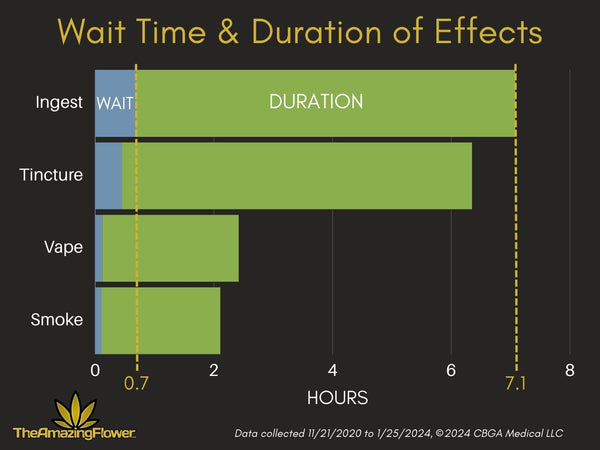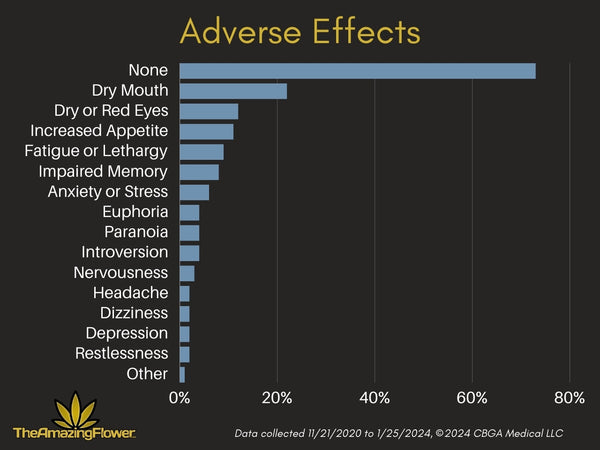Survey Results
This page has some early results of our cannabis and hemp effectiveness research project (via a simple, standardized survey). We just ask people to tell us about "What Works Best" for their goals.
We understand people may have several symptoms or goals in mind when they consider cannabinoid products, so we encourage everyone to take one survey for each symptom or goal.
Our survey collects anonymous, self-reported, observational, real-world marketing research data - not clinical data. We collect the data and publish summary results for free to everyone right here. We don't sell any of our data. Anyone who is interested can see it here.
To show "statistically significant" correlations about active ingredients and effectiveness, we need a LOT of survey responses. MANY, MANY thousands. So we encourage everyone to share their formal, anonymous "anecdote" by taking our survey. Just tell us what works well for you!
Please ask your friends and family to take a survey if they've found something that works for them. We send everyone who takes it two of our convenient Pocket Guides and a holographic sticker for their trouble. Cannabis and hemp "anecdotes" collected in the same way with the same survey can quickly become real actionable knowledge.
The following summary reports and charts cover important aspects of cannabis or hemp product choices and their self-reported effectiveness for people with different types of medical symptoms and adult use goals.
We distinguish between medical use and adult use (recreational), however we understand there is significant overlap - the distinction is by no means clear. Many consumers may not have a diagnosed medical symptom they are treating, but the effects could very well improve their health-related quality of life.
Sleep is a good example of this crossover. Over half of recreational, adult users tell us that "improve my sleep" is a top goal for their cannabinoid consumption. Few would argue that better sleep isn't good for your physical and mental health.
So, our goal is to help both patients and consumers by publishing summary reports and charts of what others say works well for them. Always keep in mind that everyone has unique biochemistry and what works well for one person may be totally ineffective or even detrimental for another. But we think it's always good to understand what works well for others as we each use trial and error to figure out what works best for us.
If you have any suggestions to make the reports we publish better, we encourage you to let us know by email: cs@cbgamedical.com. Thank you for your support!
Data was collected from November 2020 to February 2025. We continue to collect it and usually update the reports every year.
Medical Symptoms
These are the top medical symptoms our respondents are treating with cannabinoid products. Pain is by far the most common (33% of respondents), with anxiety (17%) and PTSD (10%) as second and third most common medical symptoms.

Adult Use Goals
Here is what people tell us about their adult use goals for cannabinoid products. Relaxation is most common with about 77% stating it as a primary goal. You can select multiple adult use goals so the totals do not sum to 100%.
The rest of this page is dedicated to Medical Use results since our primary mission is to help patients.

Effectiveness for Pain
Pain is the most prevalent medical symptom that we hear about in the survey, with one third stating it as a primary medical symptom they are treating with cannabinoid medicine. Here is what people tell us about the effectiveness of their "best" method of administration of cannabinoid medicine for pain.
Ingesting and Topical application of cannabinoids are reported to be more effective than smoking or vaporizing for pain, although all methods seem to provide significant relief. Here are some quick summaries of quite a few published studies on cannabinoids and pain. If you are interested, here are a few studies about topicals.

Effectiveness for Anxiety
Vaping is reported to be the most effective administration method for anxiety, but all major methods deliver between 74% and 78% effectiveness for anxiety according to our respondents. Here are summaries of quite a few published studies on cannabinoids and anxiety.

Effectiveness for PTSD
Vaping is reported to be the most effective cannabinoid administration method for PTSD patients at 80% effective, but just barely. Smoking is also very effective at 79% according to our respondents. Ingesting is reported at 75% effective. Here are summaries of some published studies on cannabinoids and PTSD.

Effectiveness for Insomnia
All methods of consumption were reported as 75% or more effective for assisting patients with sleep disorders. Ingesting was on average the most effective at 80%,
Quick summaries of some published research on sleep disorders and insomnia are here.

Effectiveness for Arthritis
The average effectiveness for the top methods of cannabinoid consumption for arthritis symptoms ranged from 75% to 79%. Ingesting was rated most effective at 79% with the vast majority of patients using this method (67%). Ingesting usually lasts much longer than the other methods, and longer relief with easy dosing is an obvious advantage of ingesting cannabinoids.
Here are some quick summaries of published research for arthritis.
Effectiveness for Headaches
Vaping is reported to be the most effective cannabinoid administration method for headaches or migraines at 83% effective. Ingesting and mucosal (or tincture) administration were rated 80% and 78% effective at relieving symptoms. Smoking is rated significantly less effective at only 55% according to our respondents.
A placebo-controlled randomized trial concluded that vaporizing flower with about a 1:2 THC:CBD ratio was effective for migraine relief. That ratio outperformed THC-dominant and CBD-dominant flower. Several other published studies have also shown effectiveness.

Wait time and Duration
People tell us that the wait time to feel effects and the duration of those effects varies a lot based on the method of administration. The effects from inhaling smoke or vapor begin very fast (<10 minutes) and then last about 2 hours, on average. Ingesting (swallowing) takes about 40 minutes to start but lasts an average of about 6.4 hours.
Tincture effects take about half an hour to start and last an average of 5.9 hours, almost as long as ingesting (6.4 hours). Recent research indicates that often tinctures are swallowed before they are absorbed mucosally, so they end up being processed in the liver like ingested products.

Side Effects

We will be adding to and updating this results page periodically as we collect more data. Our research project has no end date, because new product development will continue, and we see our work as a "living" analysis.
It will be developing with new insights for many years to come. Thank you for your help in de-stigmatizing perhaps the most powerful and misunderstood plant on earth!
And don't forget to encourage your friends and family to contribute to our research by taking a quick survey about "What Works Best" for them. Every story matters. Thank you!
